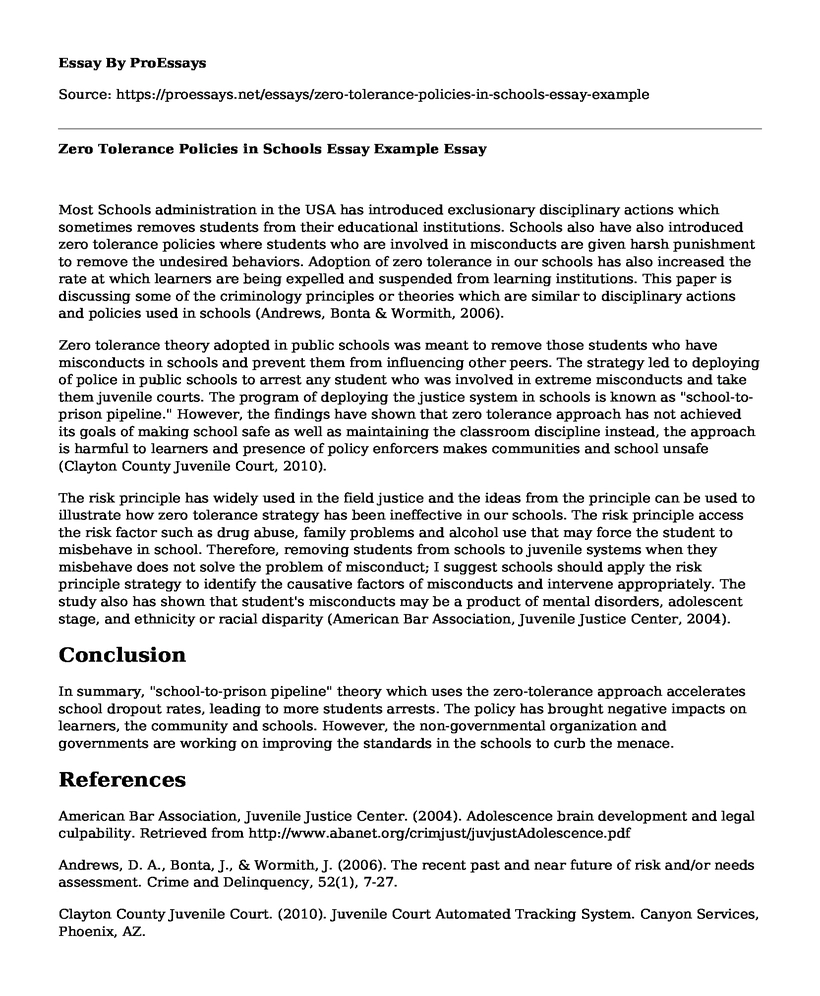Most Schools administration in the USA has introduced exclusionary disciplinary actions which sometimes removes students from their educational institutions. Schools also have also introduced zero tolerance policies where students who are involved in misconducts are given harsh punishment to remove the undesired behaviors. Adoption of zero tolerance in our schools has also increased the rate at which learners are being expelled and suspended from learning institutions. This paper is discussing some of the criminology principles or theories which are similar to disciplinary actions and policies used in schools (Andrews, Bonta & Wormith, 2006).
Zero tolerance theory adopted in public schools was meant to remove those students who have misconducts in schools and prevent them from influencing other peers. The strategy led to deploying of police in public schools to arrest any student who was involved in extreme misconducts and take them juvenile courts. The program of deploying the justice system in schools is known as "school-to-prison pipeline." However, the findings have shown that zero tolerance approach has not achieved its goals of making school safe as well as maintaining the classroom discipline instead, the approach is harmful to learners and presence of policy enforcers makes communities and school unsafe (Clayton County Juvenile Court, 2010).
The risk principle has widely used in the field justice and the ideas from the principle can be used to illustrate how zero tolerance strategy has been ineffective in our schools. The risk principle access the risk factor such as drug abuse, family problems and alcohol use that may force the student to misbehave in school. Therefore, removing students from schools to juvenile systems when they misbehave does not solve the problem of misconduct; I suggest schools should apply the risk principle strategy to identify the causative factors of misconducts and intervene appropriately. The study also has shown that student's misconducts may be a product of mental disorders, adolescent stage, and ethnicity or racial disparity (American Bar Association, Juvenile Justice Center, 2004).
Conclusion
In summary, "school-to-prison pipeline" theory which uses the zero-tolerance approach accelerates school dropout rates, leading to more students arrests. The policy has brought negative impacts on learners, the community and schools. However, the non-governmental organization and governments are working on improving the standards in the schools to curb the menace.
References
American Bar Association, Juvenile Justice Center. (2004). Adolescence brain development and legal culpability. Retrieved from http://www.abanet.org/crimjust/juvjustAdolescence.pdf
Andrews, D. A., Bonta, J., & Wormith, J. (2006). The recent past and near future of risk and/or needs assessment. Crime and Delinquency, 52(1), 7-27.
Clayton County Juvenile Court. (2010). Juvenile Court Automated Tracking System. Canyon Services, Phoenix, AZ.
Cite this page
Zero Tolerance Policies in Schools Essay Example. (2022, Sep 11). Retrieved from https://proessays.net/essays/zero-tolerance-policies-in-schools-essay-example
If you are the original author of this essay and no longer wish to have it published on the ProEssays website, please click below to request its removal:
- Locke's Liberalism and Burke's Conservatism Essay
- Essay Sample on Play: A Tool for Development and Expression
- Child Development: Genes, Environment, and Play - Essay Sample
- Essay Sample on School Principal's Responsibility for Student Safety in Learning Institution
- Exploring Smoking Habits Through Research: Examining Therapeutic Counseling
- Essay Example on Tracking Physical Growth: Key to Understanding Children's Cognitive Development
- Free Paper Sample on Overcoming Tragedy: My Story of Transformation







